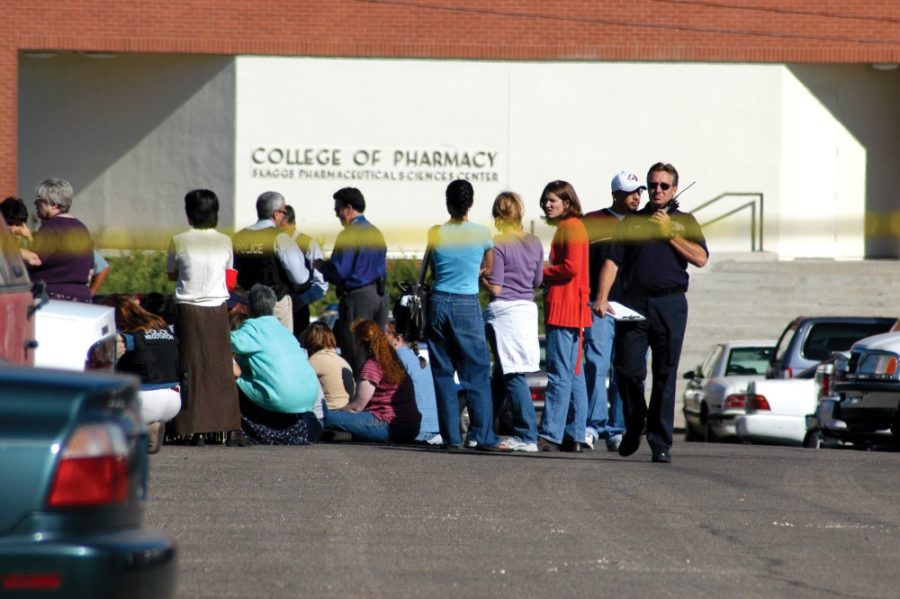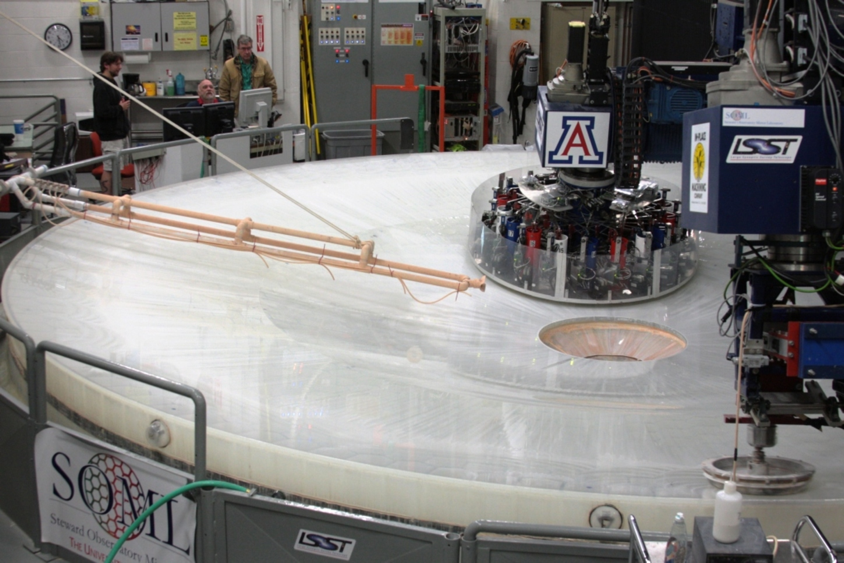It was already a restless morning for University of Arizona Police Department Officer Filbert Barrera.
Earlier that day, Oct. 28, 2002, basketball ticket sales had incited a small riot at the McKale Center, calling for an unusual need for police activity. Returning to the UAPD station from the athletic center, Barrera and his colleagues received a dispatch call they would never forget.
“I remember hearing the dispatcher and, when she came up on the air, I could already tell by the tone of her voice that something was wrong,” said Barrera, now a sergeant and public information officer for UAPD.
Shots had been fired at the UA College of Nursing while students took their midterm exams that Monday morning. The gunman, Robert Stewart Flores Jr., a third-semester nursing student, had shot and killed three of his professors in the building north of Speedway Boulevard.
After shooting and killing Professor Robin Rogers in her second floor office, Flores moved to a fourth floor classroom. In front of a classroom full of students, he killed Barbara Monroe and Cheryl McGaffic, both nursing professors.
Flores dismissed the frightened students from their classroom and then killed himself at the scene with one of the five guns he had brought to campus.
From violence to chaos, those inside frantically ran from the scene.
As one of the first responders on the chaotic scene, Barrera was overwhelmed with a flood of students and faculty fleeing from both the College of Pharmacy and College of Nursing buildings. Barrera, who has served at UAPD since 1998, recalls the intense fear in the faces of those pouring out of the buildings.
“What really was just crazy, was how chaotic it was, and you go through the building and you see people who are really, really scared,” he said. “You don’t see that often. You don’t see people who think they are going to die. That’s one thing that has always resonated with me.”
Not knowing at the time where the gunman had shot from, or if the shooter was still active, Barrera and another officer entered the Pharmacy building, while four others rushed to the Nursing building, where the scene had unfolded.
For Barrera, this was a crime different from the rest, a crime of a scale UAPD had never dealt with before and never has since.
“It’s a unique feeling when you are going through a building with your gun out, and people are scared for their lives, and you can see it in their eyes,” Barrera said.
The scene spoke for themselves. Barrera remembers the surreal feeling of lifelessness in the room holding the students’ unclaimed belongings amid a grisly scene. Bags, lunches, computers. All left behind in the chaos of the moment.
“Going through the building after we had it cleared, it’s just amazing how a building can have a life based on the people that are in it and that one was just void of that afterwards,” Barrera said. “It’s like the wind had picked up everyone and just left all their belongings, it’s just eerie, … you try to catch your breath for [a] moment, and it’s completely quiet in a place that’s supposed to be busy.”
That deadly morning, the College of Nursing lost three valued members of the UA family.
The first victim, assistant professor Robin Rogers, 50, served as a faculty member for six years and contributed to the field of pediatrics before the shooting.
Professor Cheryl McGaffic served as a registered nurse for 21 years and contributed to the UA College of Nursing through research and charity. She was 44.
The last to die that day was Barbara Monroe, 45, a professor who had joined the UA College of Nursing faculty only a year prior.
The three women are memorialized on the UA campus at the Women’s Plaza of Honor, where a freestanding bench resides in their honor for their service at the UA and where annual candlelight vigils are held by the College of Nursing.
Through trauma came community healing.
While three families lost loved ones on this tragic day, it also marked a loss for the entire UA community. Students lost teachers and also a sense of security in the classroom. This was not just a tragedy for some, but one that resonated with all of those connected to the university.
Melissa Vito, current vice president for student affairs and enrollment management, remembers that day and the need for counseling for the students who witnessed the tragedy. Vito, the dean of students at the time, heard the news while on her way to Phoenix.
With students distraught and without a place to go, Vito and members of the Associated Students of the University of Arizona, utilized the Swede Johnson Building to house, counsel and help return abandoned items to the students who had fled from the violent scene.
Within the day, those from Life and Work Connections, a UA program that aids employees and students, and ASUA helped work toward a sense of normalcy within a shaken community.
“You know, you had students whose car was parked in the area that had been set up as a crime scene,” Vito said. “We really had to figure out what those needs were and working with a team, and to help figure out ways to do it.”
Then-UA President Peter Likins, recounted the day and the efforts to help those students who had witnessed the killings and to foster a sense of strength for them through the traumatic event.
Likins also recalled a sense of extreme worry throughout the campus. The shooting occurred just a year after the September 11 attacks. However, he stressed that this day was not meant for students and faculty to live in fear, but to come together as a community.
“In the middle of the confusion, … I said, ‘It is important to distinguish between grief and fear,’” Likins recounted. “‘This is a time for grief, and we need to focus on grief. We need to focus on the victims, not on the killer, not on future dangers. Right now, we focus on those living.’”
UAPD Chief Brian Seastone recalled the unwavering support that all members of the UA community were able to provide after the shooting.
“There were many things that day,” Seastone said. “Obviously, the tragedy is always going to be there, but it was the amazing outpouring of support that not only law enforcement, and the first responders had from people offering help … that will always stay with me, just the care and compassion that everybody showed that day.”
With a tragedy, progression works towards prevention.
With recent campus shootings making headlines with seemingly great frequency, there are many factors to consider in regard to changes made in UA security since 2002. Changes that can answer questions like: How can an attack like this be prevented? If this kind of attack were to happen again, is the UA ready?
Before the shooting, Barrera recalled reading a report from a concerned professor regarding the behavior of the gunman during class.
“Someone had called and complained about Mr. Flores, I want to say about a year before this, and I remember hearing his name and going ‘I think I took that call,’” Barrera said. “They voiced concerns about how he was behaving and I was prepared to go talk to him and I remember she said, whoever the dean was at the time, ‘We just want to report this right now and we are going to talk to him and deal with this academically,’ and I’m sure for a while it was … until he just spiraled out of control.”
Since the shooting 13 years ago, changes were made in how the UA prepares for and tries to prevent these situations.
A report on the shooting led to the implementation of new policies that gave instructors an opportunity to speak out against questionable behavior from students in the classroom.
The Disruptive and Threatening Student Behavior Guidelines were put in place after the 2002 shooting, as well as the Campus Emergency Response Team, or CERT, to further enhance the emergency preparation process.
Even with the advancements that the UA has made to further prevent tragedies like that in 2002, one thing that has not changed is the importance of community involvement with the authorities — a point UAPD stresses.
It’s also now easier, with the progression that technology has made in the past decade, for the public to reach authorities in seconds via social media, Seastone said.
Many people believe that it is not their place to step in and tell police that someone or something is stranger than normal. Too many tragedies could have been prevented if certain measures were taken, Barrera said.
He stresses that the only way special policies can prevent crime is if people voice their concern to police and speak up.
“I would tell people to call us, it doesn’t matter how small or how big, but I want people to call us,” Barrera said. “Crimes are solved by people calling the police, call us … please.”
“Our job is to try and get into stuff, to try and go find things, but sometimes it finds you,” he said.
Follow Lauren Renteria on Twitter.









